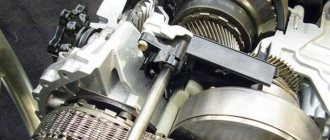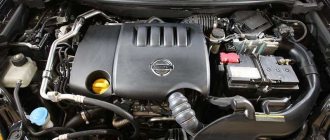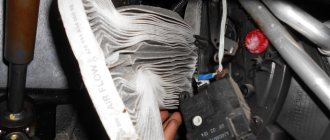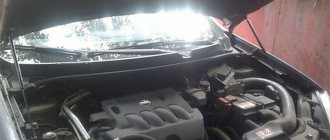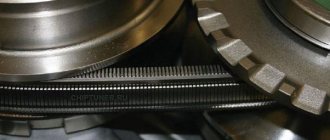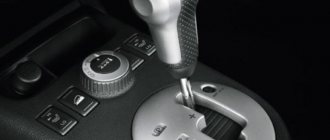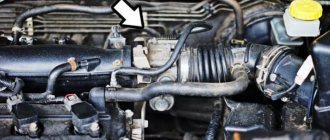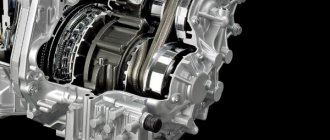Home / Crossovers
Back
Published: 07/31/2018
Reading time: 8 min
0
14690
Rate this article
The products of the Japanese automobile manufacturer have been very popular among domestic vehicle enthusiasts for several years now. This is especially true for the Nissan Qashqai crossover. This car has good cross-country ability, stylish design and good technical parameters, as a result of which the demand for it is quite high.
However, before purchasing a car, it is important to know everything about it. Including what kind of gearbox will be installed on the car. In this article we will answer the question: “Qashqai: automatic or CVT?”, and also discuss the features of operating the gearbox on this vehicle .
- What boxes are placed on Qashqai
- Features of the Nissan CVT
- How long does a CVT run on a Nissan Qashqai?
- How to extend the service life of a gearbox
- Nissan Qashqai CVT: problems
- How to identify problems with the CVT
- A short summary
CVT modifications
A variator (CVT) has been installed on Nissan Qashqai cars since the very beginning of production, that is, since 2007. In 2010, the car was restyled, but the CVT gearbox remained virtually unchanged.
When you're the undisputed leader in a category, changing too much can mean a huge boost in sales. It has grown by five centimeters in length, two in width and is reducing its height. This means that its exterior is much more rugged, but the important thing is that it offers more battle, so the interior space is wider.
What kind of variator is installed and its operating principle
Although what has improved the most is the driving feel. In fact, taking into account that most of the time this type of vehicle moves between traffic lights, it should be noted that it has a Start-Stop series. He has many arguments to remain a leader for years. The latter can be combined with all-wheel drive. From the most economical version, the donation series is completely completed.
In 2014, Nissan releases the updated Qashqai. This time the gearbox was also modernized.
Nissans have CVTs from the Japanese company Jatco. The new Qashqai received an improved model based on the previous JF011E. Box JF011E (other marking RE0F10A) is very popular. It was released in 2004 and is intended for engines from 1.6 to 2.5 liters.
Technology, one of its strengths
This new engine is available with front-wheel drive and a six-speed manual transmission. As for the direction of the electrical equipment, you can't expect a firm touch and a lot of information in your hands, but the overall driving behavior is satisfactory.
Engines and mechanics of great reliability
Circulation at normal speeds, the noise level that comes from the hood is quite acceptable, since the unit is quite well insulated. The best: no vibrations that, several times at idle, make you hesitate and look at the rev counter to confirm that the engine is on. That is, the times in which the Start-Stop system is included as standard are not undertaken. This element further contributes to the reduction in consumption, which can be less than seven liters per hundred kilometers.
It was the result of the modernization of another box RE0F06A, which has been produced since 1999 and was also deservedly appreciated.
Thus, at the moment, two types of JF011E can be found on Qashqais: the model before 2014 and the updated one after 2014. A similar box is installed on Dodge Caliber, Jeep Compass, Citroen C-Crosser, Renault (Scenic, Megane, Koleos), Peugeot 4007, some Mitsubishi and Samsung cars, and, of course, Nissan Qashqai, X-Trail, Tiida and Teana.
It is clear that if the car is forced, the front axle tends to move to the side and that the solid-rod versions convey greater safety, but even so the limit is high and the body does not balance too much when changing trajectory. For this reason, and although we brought it to you a few days ago, today we will focus on the special "Tenth Anniversary" version that we were able to test during the crossover dominance days held by the brand in Spain.
This special edition is characterized by its own decorative elements, such as carbon fittings, special door security devices or an identification plate with the serial number of each device.
We are in front of a car that takes into account the comfort of passengers, but this does not mean that it is soft at the level of the suspensions.
The life of nomads is difficult and, moreover, in such indecent places as ancient Persia, where Kashgai survived for a thousand years caring for their livestock and fighting their enemies.
Operating rules
The Nissan Qashqai variator requires certain rules when driving the car:
- You should drive smoothly, avoiding sudden acceleration and braking;
- Do not try to pull out a stuck car by rocking. The variator needs to come to a complete stop and only then can it switch to another mode;
- when the power unit is idling, the gearbox modes must be switched smoothly;
- Avoid constant driving at high speeds;
- do not tow other vehicles or trailers;
- avoid wheel slip.
Reliability
Almost all automobile CVTs in the world are produced by one Japanese plant, Jatco. The manufacturer gives its guarantee on the CVT for those car brands that buy them. For Nissan Qashqai, this figure is 120 thousand km. Nissan itself, naturally, gives a shorter guarantee: 100 thousand km for the entire car, including CVT.
In terms of aesthetics, he opted for a relatively conservative formula with a sharper line - his body is now longer, wider and lower, but it bears an undeniable resemblance to its predecessor. The switch allows you to choose between front and front traction with a progressive link to the rear axle in case of loss of traction or total with a locked center bulkhead.
It should be borne in mind that always in these systems - that in the first mode there is no complete release of the rear train, in the second we do not have a completely constant overall traction system, and in the third the clutch disappears if it exceeds a certain speed or if a certain resistance to attack is exceeded, which is often happens if we really need a lock and we have, for example, a wheel stuck in a ditch.
The actual service life of the variator, according to various estimates, is from 130-150,000 km, to 200,000 km, with correct switching (full stop) and timely flushing of the radiators + changing the oil in the variator.
Under increased load, naturally, the variator will last less.
What should the oil level be in the Nissan Qashqai variator?
In order to correctly check the oil level in the Nissan Qashqai variator, you must perform the following procedure:
- The oil in the variator must be heated to 50-80 degrees C. To do this, the manufacturer recommends warming it up while driving. At an ambient temperature of 20 degrees C, the required oil temperature in the variator is achieved according to the recommendations after about 10 minutes of driving in normal mode.
- After the run, we stop the car on a level surface and do not turn off the engine.
- Apply the handbrake securely.
- With the brake pedal pressed, move the variator mode switch lever to all positions one by one, holding each position for a few seconds.
- Move the mode selection lever to position P or N. The engine should continue to run.
- We remove the oil level dipstick by releasing the latch of the dipstick head mechanism.
- We wipe the dipstick from oil using special or any smooth paper. Do not use rags or other materials to wipe the dipstick that could leave behind pieces of material, threads or other foreign bodies.
- We insert the probe back, turning the probe head 180 degrees relative to its original position!!!!!
- We take out the dipstick and check the oil level according to. probe sector.
- We insert the probe back, turning it over again and placing the probe head in its original position, which was in the latched position of the head.
- Securely lock the probe head lock.
- The same oil level in the variator with the engine not running and with the engine running may indicate a malfunction of the oil pump or its beginning.
Service
- replacing the external oil filter cartridge - every 30,000 - 50,000 km;
- oil change - every 60,000 - 100,000 km.
Unscheduled repair work may include:
The car looks premium, corners well, brakes well without overcompressing the front suspension, and sits well on the rear axle. The devices tested in the model presentation installed 100% asphalt tires. The first is a signal reader that constantly informs you of the maximum speed allowed when passing through the on-board computer; This is useful.
Secondly, there is lane change warning, which does not correct the vehicle's trajectory, but notifies the driver via vibrations on the steering wheel; This is also useful. The third consists of a system that automatically activates the main beam; it is convenient, but easily confused with reflecting traffic signals, for example.
- replacing the metal internal oil filter;
- replacement of pump seals and axle shafts;
- replacement of a stepper motor (step motor);
- replacement of the high pressure pump valve and the pump itself;
- replacement of clutches and sealing rings;
- replacing the speed sensor;
- replacement of shaft bearings;
- replacement of selenoids;
- belt replacement;
- replacement of cones.
Consumption of Nissan Qashqai with CVT
The real fuel consumption of a Qashqai with a CVT and a 2-liter engine in the city is an average of 8.3 liters per 100 km, on the highway in cruising mode - 6.5 liters.
Additionally, LED daytime running lights and fog lights are standard. Do you see the light? Side indicators are built into the rearview mirrors; they, in addition to being piran in body color, are electrically adjustable and heated as standard.
Towing and trailer
That's right, the pedal feel is a bit sensitive at the beginning of the journey. So they are not cheap, but they are interesting. His touch is too rough. 2. Franco-Japanese duel of heights in the fashion segment on a larger scale than it seems. They are 4.45 meters long Qajar by 4.37 Kashgai, why the first one does it better when traveling and the second one in the city in terms of size. The rim design and large overlays on the skirts are an additional aesthetic contribution to the Qajar.
Qashqai 2011 is a fairly popular car in Russia. Most people prefer . This car is equipped with one of two options: a variator, which is very similar to an automatic, and a manual transmission. Everyone chooses what they like best.
Sound check
As we have already said, although this method involves checking on the go, both methods will not necessarily give a positive result and will not necessarily give a negative result. Although these checks are carried out together, the outcome of each of them is independent.
So, the owner agreed to conduct a short test drive, and you sat behind the wheel, or even in the passenger seat - you don’t have to drive the car to check the sound. First of all, listen to the operation of the variator at idle - here you should only hear the engine, the box does not make any sounds at idle.
Based on the design features, the variator also does not make any particular sounds while driving. If the sound insulation of the car is not up to par, then you can hear a quiet and uniform sound of the variator, but in no case should there be sharp sounds such as clicks or an increasing howl - this indicates a malfunction of the box.
Some sounds may be due to worn pulleys. In this case, the car will make a hum while driving, and you should definitely listen to it, since the sound is very similar to the hum from worn out bearings.
Not catching this sound can be dangerous, however, its absence, although a reason for optimism, is still not so strong, since problems of this kind with the variator can arise at a variety of mileages - both at 50 thousand and over a hundred - this solves a lot the driving style of the car owner and the model of the car and the variator itself.
If you are not sure that these methods are for you, or you are afraid of missing something important when checking the variator, then you can apply for the Autocode on-site inspection service, and the specialist will inspect the car right at the place of purchase, or order a car history check using the VIN or state registration number. number to "Autocode". Thanks to the service, you will find out the actual mileage of the car and whether it has had an accident - the main points that will tell you whether it is worth taking a closer look at the car in principle, and in what condition its CVT transmission is supposed to be.
Device
This device on Qashqai has an English designation - CVT, and stands for continuously variable transmission. This is a variation, so to speak, of an automatic transmission. It’s difficult to immediately notice its peculiarity, since it has two pedals, the transmission modes, like the lever itself, do not differ much from a traditional automatic transmission.
The thing about the face of both models is to see that they start from the same base, although the two years difference between them seems to favor the design language of Kajar and Renault. In any case, the grille is similar, as is the design of the daytime running lights and fog lights.
We have a similar feeling in the rear, with the interpretation of the optics, diffuser and third brake light. As befits his larger size, Kajar wins the boot, but that's not why. They amount to 472 liters for 430 Japanese.
Subtle are also changes expressed in the interior of both cars. The configuration of the dashboard, center console or multifunction steering wheel is similar to its nuances. A more modern moment in the second, although without frills. Apart from the size of both cars and the design language used in each, it is in the petrol engine range where the most important changes are assessed.
The difference lies in its work itself. The variator does not have a fixed first, second or tenth gear. He has a lot of passes. Switching between them is so easy and smooth that it is difficult to notice. Here you won’t be able to feel the shocks either when starting or when switching, since there are none. To put it more correctly, there are no switches at all. The car will not slip out of the blue. The device itself gradually and constantly changes the gear ratio when necessary: accelerating or decelerating the car.
These updates make the model even more competitive and responsive to the needs of the Brazilian market. Manufactured in Mexico specifically to serve the Brazilian market, the 0 16 V engine, praised by consumers and the specialist press for its excellent performance, is now biofuel. These new parts include intake and exhaust valves and seals made from new materials, the first anodized steel piston ring, stronger connecting rods, fuel injectors suitable for ethanol use and a dual-layer lambda probe for improved moisture resistance of vegetable fuels.
Content
A CVT is similar to an automatic gearbox in that you do not need to set the speed yourself using the transmission lever. However, in its operation it has significant differences: if the “automatic” includes fixed gears, usually in the number of four to nine, then the variator is a continuously variable transmission that does not have fixed steps.
In other words, if an automatic transmission alternately includes fixed stages, then the variator works from the lower to the upper threshold, without having intermediate “stops” on the way to increasing the gear ratio.
So, in what ways can the variator be checked if you have already met with the seller and are inspecting the car:
- Checking the oil in the variator;
- Check in motion;
- Sound check.
The second and third methods may seem similar, but they are only adjacent; one may not give a complete picture without the other.
Despite the fact that a standard “automatic” with a torque converter is considered the preferred transmission option, a variator is considered more modern, although it is not without its flaws and shortcomings, and in some ways is inferior to an automatic transmission.
Let's talk in more detail about ways to check the variator.
CVT gearbox for Qashqai
Nissan Qashqai 2012 has a special CVT transmission, so to speak, of a new generation. It was created by Japanese manufacturers who worked in collaboration with Jacto specialists. When setting up this system, Nissan technicians installed a transmission from Audi (a popular car brand), which is called multitronic.
CVT gearbox for Qashqai
All these changes increased power from 142 to 143 horsepower, whether on gasoline or alcohol.
This system makes the efficiency the same in any rotation mode, providing more precise throttle response, higher fuel efficiency, better fuel combustion and, as a result, lower pollutant emissions. Its torque curve is constant and very smooth from very low revs, giving the driver a feeling of power from the engine. Extremely flexible, has power to spare at any rotation, reaching 90% of maximum torque up to 400 rpm. The cold start tank is located inside the engine compartment. Unlike most competitors, the filling nozzle of this tray is protected by a plastic box. The cover opens towards the engine to avoid the risk of fuel leaking to peripheral components.
In such modern CVTs, improved parts have been installed that reduce the size of the system by 10%, which greatly reduces the weight of the car and improves.
Advantages and disadvantages
The main advantages of the variator are:
- general provision of favorable engine operating conditions;
- unlike a conventional stepped automatic, the variator does not put shock loads on the engine when switching to a lower gear for intense acceleration;
- due to smooth speed control, good fuel efficiency is ensured;
- With a working variator, the Qashqai practically does not slip on slippery or sandy soils.
However, along with the positive aspects, the variator also has weaknesses:
- complexity and relatively high cost of box maintenance;
- impossibility of using CVTs on powerful engines (more than 200 hp);
- not suitable for those who like aggressive driving;
- the variator is equipped with a complex electronic system with a large number of sensors and connectors, so the output of at least one of them puts the box into emergency mode;
- To service the box, you need to use only original oils and parts.
But if all operating rules are followed, the Nissan Qashqai variator will prove to be a reliable and trouble-free unit.
Signs of breakdown
If it seems that there are breakdowns in the gearbox, it has started to work strangely, then self-diagnosis of the automatic transmission is necessary. There are the most common signs of a variator malfunction:
Among the main new features are folding rear-view mirrors, both front and rear, available in all versions of the model. Other standard equipment on all versions is automatic locking of speed-sensitive doors and internal carpet trunk protection. Most consumers understand that a sedan must have good design, good value for money, comfort and performance, among other things.
See what's new for each version. New 16-inch alloy wheels. Steering wheel adjustment Steering wheel adjustment in black. The air conditioning has a variable compressor to cool the cabin faster. Finishing materials and fineness of finishing are also important. Cup holders are distributed in the center console and in the rear seat armrest and are adjustable to accommodate containers from 500 ml to 1 liter. There is still space in the ceiling to accommodate eight more CDs.
- There were a lot of slippages.
- A signal has been detected on the instrument panel, which indicates an emergency mode of the automatic transmission.
- Some drivers o. In this case, you also need to check the pillows.
- Jerks began to appear when shifting down or up in any gear. The car began to jerk both hot and cold.
- I began to feel some knocks in the transmission when the car was running. Kicks frequently or does not stop kicking at all.
- Braking often occurs, the transmission is “stupid”, clicks and makes noise.
Be sure to ask how to check the box. Diagnostics should be regular, at least you need to change the oil and filter on time, and sometimes you need to flush the valve body. And don’t forget that you need to check the oil level in the box yourself regularly, since overhauling it is not a cheap operation.
PryazhonovPodbor › Blog › Checking the variator (CVT) of a used car
Friends, hello everyone!
First of all, I congratulate everyone on the new year 2017! Hurray! :)) And secondly, today I want to share with you information about CVTs, namely their testing on a used car. CVT, Continuously Variable Transmission
Everyone has long known that variators are structurally a system of two cone-shaped pulleys connected to each other by a belt drive. Each pulley contains a pair of cones directed towards each other, the mutual approach or distance of which during engine operation leads to a change in the radius of movement of the V-shaped closed belt or chain. Due to this, the change in gear ratio occurs smoothly.
CVTs are most widely used on cars of the Renault-Nissan concern. The unit is manufactured in Japan, and the most common model is JF011E. Among the Nissans, the X-Trail (T-31 body), Qashqai and Teana can boast of this CVT. Renault has Latitude, Koleos, Megan, Scenic and Fluence. In addition, Mitsubishi uses Jatko CVTs on the Lancer and Outlander models. They are also installed on the co-platform French crossovers Citroen S-Crosser and Peugeot 4008. But that's not all. "Suzuki-Kizashi", "Dodge-Caliber" and "Jeep-Compass" - they also have a Jatko variator!
Now closer to the point - what to look for when inspecting a car
with this type of gearbox?
The first thing that should make you wary is the jerking
of the car during acceleration. Ideally, the car should pick up speed smoothly (such as an electric car or trolleybus) at constant engine speed. If jerks or dips are clearly noticeable, then first of all you need to check... the engine itself. The variator may have nothing to do with it. But if the engine is known to be in good working order and runs smoothly, but the car still jerks when accelerating, then this most likely means that the variator is on its last days (months at best).
Next, we look at the engine speed during uniform movement: at a speed of 80 km/h, the tachometer needle should show approximately 2000-3000 rpm. If the arrow goes off scale beyond the 4000 rpm mark. per minute, then the variator is faulty. A clear indication of a breakdown will be an attempt by the engine to stall when braking. In this case, transmission repair is not far off and it is better to refuse to purchase such a copy. It would not be superfluous to check the level and condition of the oil poured into the variator.
Continuously variable transmissions are very susceptible (much more than automatic transmissions) to oil starvation. Therefore, the level must be normal. Black oil is unacceptable. This means that there is no point in changing it - the variator needs to be disassembled and repaired. To be sure, CVT experts advise dropping some oil onto a white sheet of paper and holding the resulting stain up to the light. It may be yellow or red
, but in no case brown or brown-black. Even if the seller (trying to hide signs of wear on the variator) changed the oil, the burning smell will still remain. It smells burnt - there is no need to continue the diagnosis.
Signs of CVT failure (for all types): noise, grunts, rumble (reminiscent of a faulty TAZ rear gearbox). How to diagnose: turn off the air conditioning and music at speed
60 from mode D to N and listen to the sound source. Most often, sounds are produced by bearings, being one of the most loaded elements. Be sure to check how the car moves at a constant speed, incl. in cruise control mode!
The most common malfunction of a variator is wear of the cone bearings, accompanied by a characteristic hum. Sometimes, during diagnostics, the noise of the variator is attributed to the front wheel bearings - and they are replaced with new ones, but the noise does not go away...
The first symptoms may appear already after a mileage of 50,000 km. Replacing four bearings with spare parts will cost 35,000 - 40,000 rubles. Most often, Nissan Qashqai suffers from this disease, less often - X-Trail, and least of all - Mitsubishi Outlander. With the latter, by the way, this happens at a much higher mileage: 150,000–200,000 km.
There are several reasons that lead to bearing noise. The first is that wear products fall on the working surfaces and accelerate their destruction. Two oil filters and a magnet for collecting metal powder are not able to provide a barrier to insidious wear products. Reducing oil change intervals to 30,000–50,000 km can extend bearing life. But there is no consensus even among experts, and the statistics on oil are ambiguous. There are many examples when one variator takes care of 100,000–120,000 km and remains quiet, while another in similar operating modes hums mercilessly after 50,000 km. This leads to the second reason - unstable quality of bearings. Third, bearings cannot withstand loads and are destroyed due to their low accuracy class and low dynamic load capacity.
The most serious and materially costly defect of the above is the defect of the variator transmission. It occurs when the belt slips between the pulley cones with the simultaneous formation of scoring at the ends of the belt segments and the working surfaces of the cones. This problem can only be eliminated by complete replacement.
Don’t forget to inspect the variator radiator (if there is one), check the oil level when cold and when hot (it should be different). Perhaps that's all I wanted to say in this entry. I am sure that you can buy a car with a CVT only after a good check and MANDATORY (!) computer diagnostics. It is necessary to take into account the indicator of the oil aging counter in the variator. This is a kind of indirect sign of the actual mileage and attitude towards the car.
Buy only proven used cars. Bye
Reliability
Many 2021 Qashqai cars have CVT gearboxes from the Japanese Jacto plant. A good guarantee for the variator is given by the manufacturers of this device to those companies that buy them. For Nissan Qashqai, this plant provides a warranty service life of 120,000 km. But Nissan itself slightly underestimates the resource and gives a 100,000 km guarantee for all cars with a CVT, taking into account the fact that the entire car will work with the entire load, and not just the gearbox itself.
But according to experts’ calculations, the real resource of the CVT Nissan Qashqai is slightly longer than the official one. It ranges from 130,000 km to 200,000 km, but such a long and reliable service is only possible when the radiator is flushed in a timely manner, as well as correct switching (that is, a complete stop) and changing the transmission oil when required.
Naturally, if the load is increased, the reliability of the variator decreases, and with it the service life.
Which oil is best for the Nissan Qashqai variator?
Nissan Qashqai car owners often wonder which oil is best for CVT gearboxes? Let's try to answer this question now.
So, let's begin. There are only two types of oil in the Nissan Qashqai variator. This is the transmission fluid Nissan CVT Fluid NS-2 or Nissan CVT Fluid NS-3, as well as analogs of these fluids from other class=”aligncenter” width=”849″ height=”436″[/img]
As mentioned above, the oil in the Nissan Qashqai variator must comply with NS-2 or NS-3 approval. So which one is needed? Earlier models of Nissan Qashqui are suitable for NS-2 oil, and the latest ones are suitable for NS-3 fluid. We will deal with this in detail.
- The perfect oil for Nissan Qashqai J 10 is: Transmission fluid Nissan CVT Fluid NS-2 Article number: 0.946 l – 999MP-NS200P / 4 l – KLE52-00004 / 20 l – KLE52-00002. Volume for a complete replacement is 8.3 liters.
- Nissan Qashqai+2 JJ10 Transmission fluid Nissan CVT Fluid NS-2. Article: 0.946 l – 999MP-NS200P / 4 l – KLE52-00004 / 20 l – KLE52-00002. Volume for a complete replacement is 8.3 liters.
- Nissan Qashqai J11E: Transmission fluid Nissan CVT Fluid NS-3 Article: 0.946 l – 999MPNS300P / 4 l – KLE53-00004 / 20 l – KLE53-00002. Volume for complete replacement 7.4 l
So, we have sorted out the question of what and how much oil to pour into the Nissan Qashqai variator.
Service
You should not neglect scheduled maintenance of your Nissan Qashqai 2.0, as this will help avoid possible problems in the future.
Planned maintenance consists of the following operations:
- Checking the external oil filter cartridge. If necessary, it is worth replacing, and this is done after 30–50 thousand km.
- Checking the oil level and itself. If necessary, it must be replaced, and the need for this occurs after 60–100 thousand km.
There is also work in the form of unscheduled maintenance. It is very difficult to make them with your own hands; you need to have good knowledge in this matter. Therefore, you should only list the work that can be carried out on your car. Basically it's replacing something:
- Internal oil filter.
- Speed sensor.
- The high pressure pump valve of the pump itself.
- Cones.
- Belt (sometimes a metal or rubber variator belt, sometimes a chain).
- Pump and axle shaft seals.
- Selenoidov.
- Friction clutches and sealing rings.
- Stepper motor.
- Shaft bearings.
If shifting gears is difficult, adjustment will be required.
CVT price
Naturally, the Nissan Qashqai will be cheaper, otherwise no one in Qashqai would repair its CVT. Therefore, if CVT repair is possible, then it is better to repair it. There is no need to be greedy and repair it yourself, as it is very difficult and you do not have all the repair equipment. The service will do everything right. It is difficult to say how much the repair will cost, it depends on how the variator broke and why.
If the situation is dire, then you need to buy a new mechanism. The original CVT on a Nissan Qashqai costs 1,500 USD. e. This is the average cost, since on some machines it costs about 2000 USD. e., and on others - from 1000 USD. e.
The main reasons for the failure of the variator on the Nissan Qashqai
As we have already said, not many people still believe in the reliability of CVTs. There is an opinion that they are very capricious, and it is not advisable to repair them due to the high cost of components. Official dealers practically do not carry out repairs; in most cases, a broken variator is simply replaced with a new one, the cost of which will shock the owners. By the way, the same fate awaits the owners of conventional hydromechanical “automatic machines”. Despite this, some workshops, taking advantage of the current situation, have mastered the repair of CVTs. Information from one of the representatives of such a service was used when writing this publication, which we hope will dot the i’s. To a greater extent, Jatco CVTs can be found on cars of the Renault - Nissan concern; one of the common models is JF011E. Such a variator is most often installed on the Nissan X-Trail in the T-31 body, as well as on the Qashqai and Teana. Manufacturer Renault equips JF011E for Megan, Latitude, Fluence, Scenic and Koleos cars.
Also, Jatco CVTs are often used for their models by Mitsubishi (Lancer, Outlander) and the French manufacturers of cross-platform crossovers Citroen C-Crosser and Peugeot 4008. But that’s not all. Jeep Compass, Suzuki Kizash, Dodge Caliber are also equipped with Jatco JF011E CVTs. Using this model as an example, we will tell you what diseases are found in continuously variable transmissions.
Features of driving with a variator
The most important principle of using this type of box is that you need to warm it up if the temperature outside is low. This is due to the fact that the oil used in it has its own special characteristics. When it's cold outside, the oil cools, it becomes viscous, and it takes time for it to spread throughout the entire transmission.
If you start moving when some of the elements are not lubricated, this can lead to breakdowns. For better variator service, warming up and oil distribution, it is recommended to warm it up like this: P–R–N–D.
To drive a CVT when there is severe frost outside, it should take about 30 minutes (at least) to warm up, and after that you can drive the car safely. But even when moving for some time, you need to follow certain rules. Operation during the first 5 km should be very careful, you should drive without sudden jerks. This is necessary so that the lubricant is distributed throughout the entire system.
An oil change is required every 40,000 km. Be sure to use only high-quality fluid, since the variator only works properly with it. On Qashqai, the variator has its own characteristics and “nitpicking” regarding the quality of the hydraulic fluid.
There are several rules when overtaking and turning in a Nissan CVT. This type of transmission responds to an increase in engine speed. Therefore, to change the gear ratio, you will need to increase the speed. Afterwards, the variator, following the selected mode, will perform the actions required of it, albeit with a slight delay.
Based on the same rule, controlled overtaking should be done when the speed has increased. And when you take turns, you need to press the gas exactly at the moment when you turn the steering wheel.
If you use the variator correctly, you can operate it for many years.
How to check the oil in a Nissan Qashqai variator
In order for the fluid level in the variator to be checked accurately on a Nissan Qashqai, place the car on a flat horizontal surface. The engine should be running at idle speed, i.e. Do not turn off the engine. Without releasing the brake pedal, you should sequentially move the selector through all positions - P, R, N, D. The delay in each position should be about 5-10 seconds.
After this run, you must set the selector to mode P, after which you can release the brake pedal.
Get out of the car and open the hood. You need to remove the dipstick from the variator filler neck. For those who have never done this, you should know that the neck is marked with the inscription “TRANSMISSION”, and on some modifications - CVT. To release the probe, press the lock on the probe and unlock it.
If you crawl under the hood empty-handed, you'll have to return to the car and grab a rag. The dipstick needs to be wiped dry. Make sure that there are no small particles of matter left on it. The rags must be clean and dry to prevent the ingress of dirt and water. It is better not to carry out the test during rain or snow, which can also lead to moisture getting into the liquid.
After cleaning the dipstick, it should be lowered back into the neck until it stops, leave for a short time and remove the dipstick again. Watch the latch: it should be positioned so that the probe does not snap into place. At the end of it you will see marks. They indicate the level. This is how the fluid level in the variator is checked on a Nissan Qashqai.
Normally, the liquid reaches an average value between the minimum and maximum marks marked on the surface of the dipstick, i.e. the end of the oil part is located in the hot range. If you don’t see such a mark on the dipstick, then look for marks of a different kind. It could be:
* add - 1pt; * don't - full - max. After checking, lower the dipstick back into the neck until it stops so that the latch engages. This completes the check.
